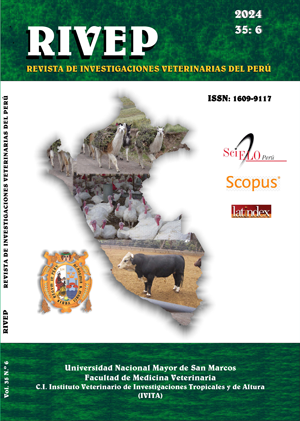Dimorphism and allometric relationships in biometric measurements of vicuñas (Vicugna vicugna mensalis) in the Andes of Oruro (Bolivia)
DOI:
https://doi.org/10.15381/rivep.v35i6.29600Keywords:
morphometry, biometry, South American camelids, fiber, correlationsAbstract
The aim of this study was to characterize the vicuñas of the Poopó Lake Basin (Oruro, Bolivia) by analysing quantitative zoometric measurements related to fibre production. In total, 108 vicuñas from three communities (Yuruna, Pumasara and Wanapa) were selected at random. The variables were live weight, height at the withers, rump width, body length, thoracic perimeter, fleece weight, fibre diameter, fibre length, and wick length. The Student t test determined that the only sexual dimorphism was in rump width, being greater in females. Factor analysis identified two principal components explaining 72.4% of the variance. Factor 1 included body size/weight measurements with allometric correlations, reflecting differential growth of body regions. Factor 2 grouped fibre and wick length. Likewise, 69.4% of positive correlations were found, evidencing a high zoometric coherence. In conclusion, sexual dimorphism was manifested only in the width of the rump, while other measurements responded to allometric relationships by body size. Morphometric measurements were mostly positively correlated and presented highly harmonious morphostructural characteristics.
Downloads
Downloads
Published
Issue
Section
License
Copyright (c) 2024 Vladimiro Ibañez, Severo Choque, Rutniss A. Vasquez, Oscar Gomez-Quispe

This work is licensed under a Creative Commons Attribution 4.0 International License.
AUTHORS RETAIN THEIR RIGHTS:
a. Authors retain their trade mark rights and patent, and also on any process or procedure described in the article.
b. Authors retain their right to share, copy, distribute, perform and publicly communicate their article (eg, to place their article in an institutional repository or publish it in a book), with an acknowledgment of its initial publication in the Revista de Investigaciones Veterinarias del Perú (RIVEP).
c. Authors retain theirs right to make a subsequent publication of their work, to use the article or any part thereof (eg a compilation of his papers, lecture notes, thesis, or a book), always indicating the source of publication (the originator of the work, journal, volume, number and date).



